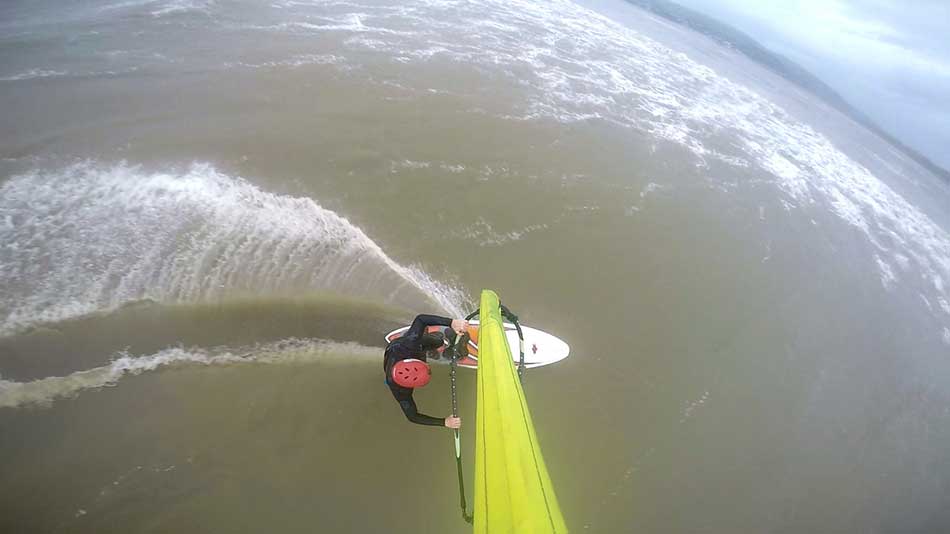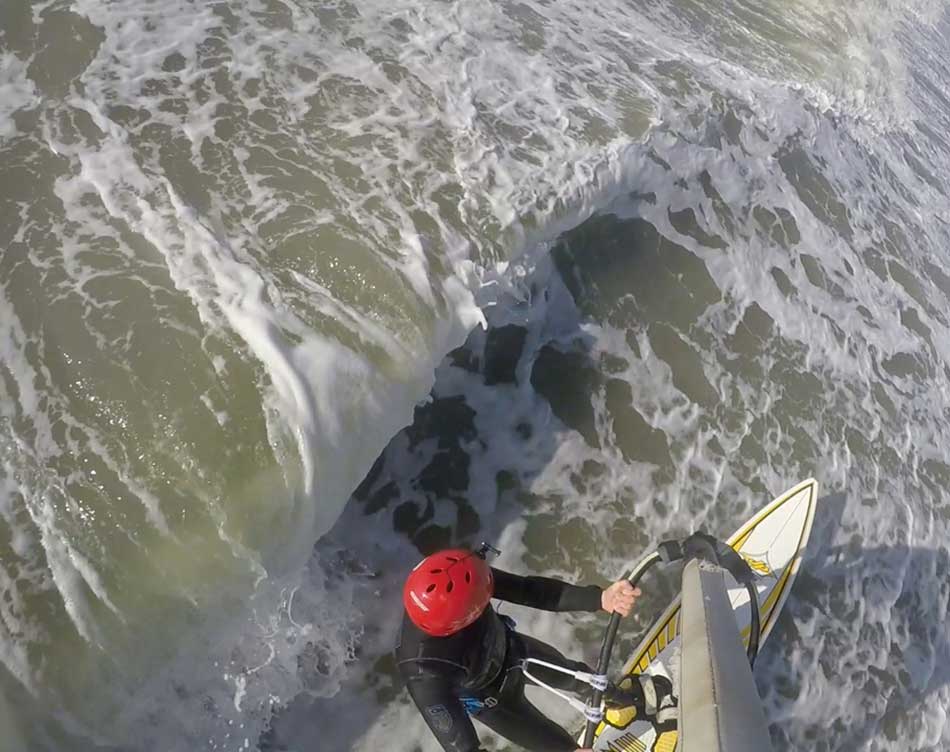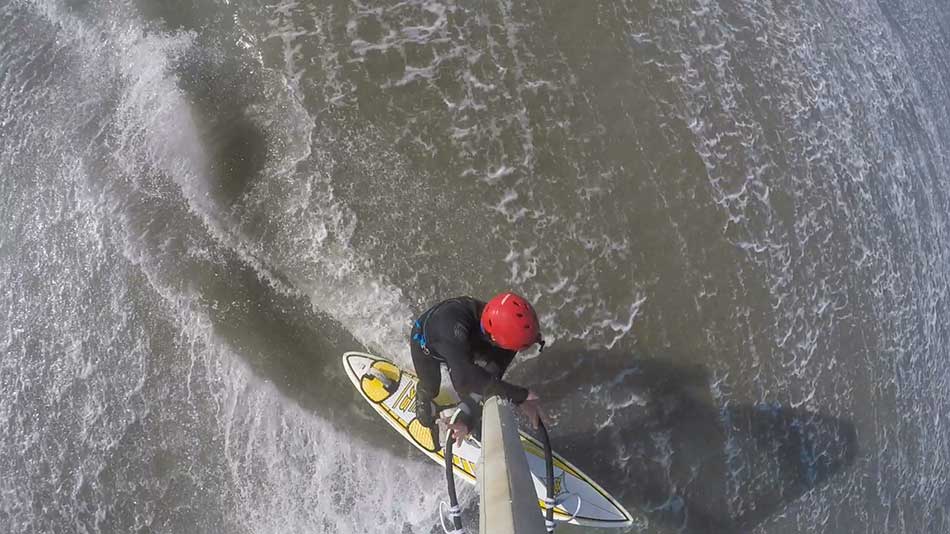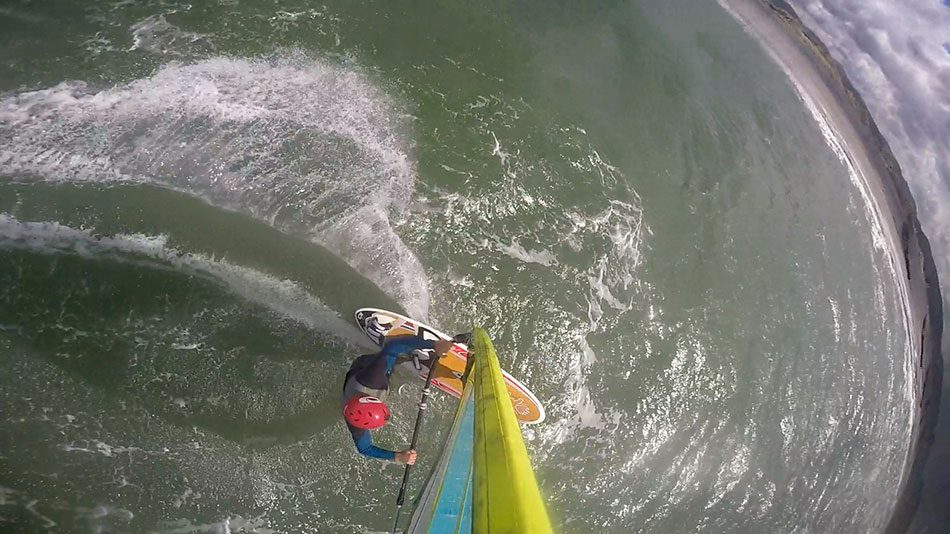The Art of Gybing
Well, that was a good few days as far as windsurfing goes. After something of a drought due to weather conditions, the winds blew, the sun shone and I was able to practise the art of gybing!

A Windy Winter
It has actually been quite a windy winter. Lockdown has however meant that people haven’t been allowed to travel so if the wind was blowing I would be the only person on the water. I was sensible enough to build a house on the beach so can windsurf without having to drive to get there. Being the only person on the water isn’t that unusual and wouldn’t be a problem for me. That is when the conditions are relatively safe.
All winter we have had strong offshore winds. Again this wouldn’t be a problem as I’d usually windsurf in the estuary in these conditions. However, the estuary is about ½ a mile down the road which is just a little too far to walk with my wheel-barrow full of windsurfing kit. I couldn’t drive there due to the restrictions. I do sometimes windsurf off the seafront in offshore winds and there were a number of days when that would have been ideal. Doing so on my own would have just been a little too risky though. All of which means that there hasn’t been a huge amount of windsurfing going on in the last few months.
Stay Local
That all changed over the last few days when a decent Westerly wind started to blow and the sun came out. Restrictions were also lifted at the weekend. No longer were we to ‘stay at home’, now we were to ‘stay local’. Fortunately it didn’t get too busy. In fact my sessions that I managed to fit in around work on Thursday and Friday were on my own as usual. I did see Lawrence head out for a kitesurf session later in the day on Friday but the beach was never crowded! Saturday saw me joined by Michele and Mike on the water. I was only out for about an hour though as I’d already cycled 40 miles and ran 5 before hand so my legs were a little beaten up and I didn’t want to break them completely!
Perfect Conditions
The winds were pretty much dead Westerly on Thursday at 30-40 knots. There were sunny spells and big, stormy seas. Friday was similar. The winds were just a touch lighter at a nice steady 30 knots and with just a little more southerly in it. Saturday was also a nice steady 30 knots and this time there was a tiny bit of northerly in it. Temperatures were around 6-7ºC. Perfect conditions really and despite the big seas fairly safe. I was even a little too warm whilst on water and I was able to let my kit dry off in the sunshine after the sessions too.
The strong winds on Thursday meant there was plenty of power to head upwind even on small kit. This allowed me to make my way out through the whitewater. The slight angle from the south and north on Friday and Saturday allowed me to do the same. That said, there wasn’t really any need to head too far out. I could just blast up and down parallel to the beach in amongst the waves.
I did of course head out the back now and then where the waves were huge. More often than not I’d get partway out only to be faced with several mountains of whitewater. Rather than try to negotiate them I’d bear away back towards the shore and outrun them instead. With the wind in this direction it was relatively easy to stay out of harms way whilst still having a blast. It was really just a case of picking the size of waves I was comfortable with and sailing that far from the beach.

That doesn’t mean there weren’t plenty of opportunities for big jumps, fun wave-rides and of course the odd crash! What it did mean though is that whatever happened you soon found yourself back on the safety of the beach.
The Art of Gybing
For those of you who haven’t ever windsurfed, there are several milestones to be achieved. There are lots in the early stages, just moving to start with, then planing, sailing in the harness, and getting your feet in the footstraps are all major milestones and at the time all quite challenging in their own right. Next is the waterstart as this allows you to sail smaller, more responsive boards and therefore sail with control in more challenging conditions. With these techniques, once you can do them they become second nature. You almost forget that you even had to learn them, they are just what you do as a windsurfer.
The next real milestone is the carve gybe. This is the art of turning around at speed and it is surprisingly hard to do. It takes thousands of attempts to pull it off and there is so much going on.
The Carve Gybe
In essence all you have to do is bear away, take you back foot out of the footstrap, unhook from the harness, move your backhand down the boom a little, swap the grip with your front hand, carve the board onto it’s edge, feather the sail to maintain power until just the right moment where you let go of the sail with your back hand, allow the sail to flip to the other tack, grab the other side of the boom with your old back hand, take you front foot out of the footstrap, keep the board trimmed and carving around to the new direction, move your old front hand from one side of the boom and use it to sheet in the sail on the other side of the boom, swap your feet around so that you are now standing on the other side of the board, hook into the harness on the new side of the sail, put your feet back into the footstraps on the new side of the board and sail away in the opposite direction.
All the while you have to be aware of what is going on around you, you have to adjust the angle of the board to cope with chop, waves and anything else that gets thrown at it, you have to lean into the turn and adjust the arc of the turn to maintain speed and you have to adjust the sail to maintain mast-foot pressure and respond to gusts or lulls. Ideally, you do all of this whilst looking nonchalant and not losing any speed.

Easy hey?! No, it’s not, and when you are learning it feels as though there is only one way to actually pull it off and millions of ways to get it wrong. Any slight error in any of those components listed above and it ends in a watery failure, In fact, more often than not even when you feel as though you’ve done everything perfectly it still ends up with a swim. When learning the art of gybing, the only thing you actually get good at is water-starting!
Getting the Art of Gybing Right
Over time you get it though. After many years of gybing you actually get to the stage where you realise that there are actually countless ways of getting it right as well as countless ways of getting it wrong. Sometimes I’ll go for a super smooth, wide-arced turning radius. I’ll keep the power in the sail all the way around and feel the wind throughout the turn. Sometimes I’ll flip the sail and sail away in the other direction before swapping my feet. Other times I’ll lay down the sail to spill some wind and swap my feet before my hands.
Sometimes I’ll use a wave to spin me around almost on the spot. Or, I might start off with a wide arc turn only to tighten it up at the end almost stalling the board. Sometimes I’ll come out fully planing. Other times I’ll opt to carve into the wind at the end of the turn a little and come off the plane to maintain control. Different conditions and different situations will call for an endless array of tweaks.
If the conditions are relatively benign I can go for style and speed. If I’m in the midst of mountains of whitewater I’m not too worried about how it looks I just want to be sure of not falling off. Every situation calls for a different technique and over the years you learn them all. This is windsurfing and the carve gybe though so you never get them all right 100% of the time.
The Perfect Gybe
As the above description would suggest, there probably isn’t a perfect gybe. It all depends on the situation. Most require some adjustment somewhere through the gybe. You almost always feel as though there’s plenty of room for improvement.

Sometimes though, just sometimes I find that I’ve simply turned around without really thinking about it. One minute I’m sailing one way, the next I’m going in the opposite direction with seemingly no loss of speed and seemingly with no effort either. It’s as if I’ve pulled off a perfect carve gybe without actually doing anything. Maybe, just maybe just that one time, I’ve perfected the art of gybing.
The hundreds of gybes that came before it all needed some effort, they all had room for improvement and there was always a chance of them going wrong. The next hundred gybes will be the same. Some of them I’ll come off the plane, some of them I’ll only just make. Others will be pretty good but not quite perfect and some will be complete failures. Every now and then though the perfect one comes along and it all feels so easy. It really does feel as though I’ve done nothing but somehow have pulled off all of the individual components needed to execute a gybe without even trying.
Granted, a few seconds later I’ll probably be brought back down to earth by a big wave, a rogue piece of chop, a gust, a lull, a crash landing from a jump or just a stupid mistake. Just occasionally though I perfect the art of gybing and all is god with the world.















I thought you were going to say you’d perfected it with absolute brilliance and here is a video !